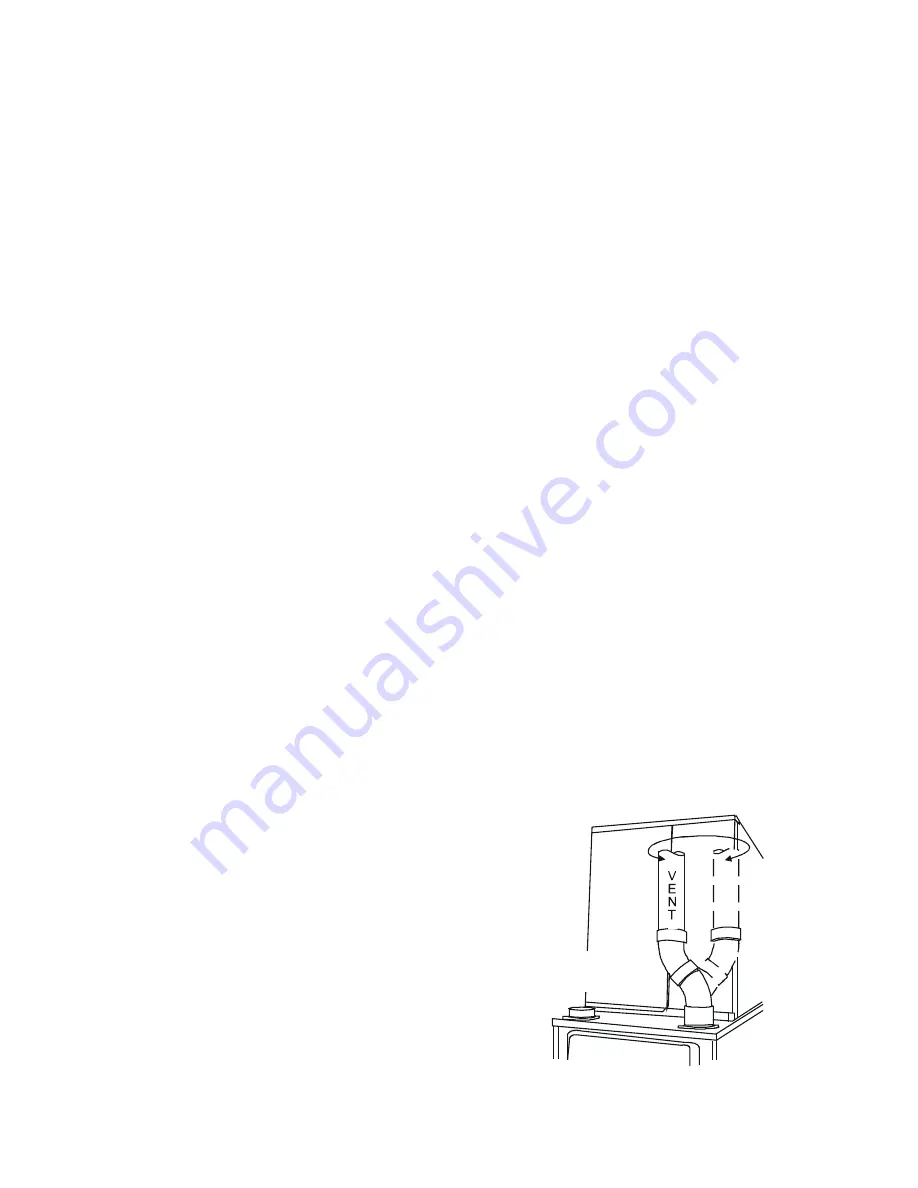
SYSTEM OPERATION
15
The following bullets and diagram describe the restrictions
concerning the appropriate location of vent/flue pipe and
combustion air intake pipe (when applicable) terminations.
Refer to
Non-Direct Vent (Single Pipe) Piping
and
Direct Vent
(Dual Pipe) Piping
located in this section for specific details
on termination construction.
•
All terminations (flue and/or intake) must be located at
least 12 inches above ground level or the anticipated
snow level.
•
Vent terminations (non-direct and direct vent) must ter
-
minate at least 3 feet above any forced air inlet located
within 10 feet.
NOTE:
This provision does not apply to the combustion
air intake termination of a direct vent application.
•
The vent termination of a
non-direct
vent
application
must terminate at least 4 feet below, 4 feet horizontally
from, or 1 foot above any door, window, or gravity air
inlet into any building.
•
The vent termination of a
direct vent
application must
terminate at least 12 inches from any opening through
which flue gases may enter a building (door, window,
or gravity air inlet).
•
The vent termination of vent pipe run vertically through
a roof must terminate at least 12 inches above the roof
line (or the anticipated snow level) and be at least 12
inches from any vertical wall (including any anticipated
snow build up).
•
A vent termination shall not terminate over public walk
-
ways or over an area where condensate or vapor could
create a nuisance or hazard or could be detrimental
to the operation of regulators, relief valves, or other
equipment.
•
The combustion air intake termination of a direct vent
application should not terminate in an area which is
frequently dusty or dirty.
NOTE: In Canada, the current edition of CAN / CSA
B149.1-15 takes precedence over the preceding termi
-
nation description.
CANADIAN VENT PIPE & COMBUSTION AIR PIPE
REQUIREMENTS
All installations in Canada must conform to the requirements
of CAN / CSA B149.1-15 code. All vent components, including
primer and cement, must be listed to ULC S636. The certi
-
fied pipe and fittings should be clearly marked with the ULC
standard “S636”. The primer and cement used must be of
the same manufacturer as the vent system. For Royal Pipe
System 636; use GVS-65 Primer (Purple) and GVS-65 PVC
Solvent Cement. For IPEX System 636, use PVC / CPVC
Primer, Purple or clear. Use PVC Solvent Cement (Gray).
For Canadian installations, ABS may be used as a combus
-
tion air pipe only. ABS is not an approved vent material in
Canada. If ABS is used as a combustion air pipe, it must be
CSA certified. Always follow the manufacturer’s instructions
in the use of primer and cement. Do not use primer and ce
-
ment around potential sources of ignition. Do not use primer
or cement beyond its expiration date.
The safe operation, as defined by ULC S636, of the vent
system is based on following these installation instructions,
the vent system manufacturer’s installation instructions, and
proper use of primer and cement. It is recommended under
this standard, that the vent system be checked once a year
by qualified service personnel. All fire stops and roof flashings
used with this system must be UL listed. Acceptability under
CAN / CSA B149.1-15 is dependent upon full compliance
with all installation instructions. Consult the authority having
jurisdiction (gas inspection authority, municipal building de
-
partment, fire department, etc.) before installation to deter
-
mine the need to obtain a permit.
*IPEX System 636™ is a
trademark of IPEX Inc.
Carefully follow the pipe manufacturers’ instructions for
cutting, cleaning, and solvent cementing PVC and / or ABS.
The vent can be run through an existing unused chimney
provided the space between the vent pipe and the chimney
is insulated and closed with a weather-tight, corrosion-resis
-
tant flashing.
STANDARD FURNACE CONNECTIONS
It is the responsibility of the installer to ensure that the piping
connections to the furnace are secure, airtight, and adequately
supported.
VENT / FLUE PIPE
The vent pipe outlet is sized to accept 2” pipe. Secure vent /
flue pipe directly into the furnace fitting with the appropriate
glue. Alternately, a small section of 2" pipe may be glued in
the furnace socket and a rubber coupling installed to allow
removal for future service. Combustion Air and Vent piping
should be routed in a manner to avoid contact with refrigerant
lines, metering devices, condensate drain lines, etc. If nec
-
essary, clearances may be increased by creating an offset
using two 45 degree elbows. This joint can be rotated on the
fitting to establish maximum clearance between refrigerant
lines, metering devices, and condensate drain lines, etc. This
joint is the equivalent of one 90 deg. elbow when considering
elbow count. (See Figure 7)
45 DEGREE
LONG-SWEEP
ELBOWS
Increased Clearance Configuration
Figure 7
____









































